If you think Mongolian beef is Mongolian cuisine, think again.
You won’t find Mongolian beef in Mongolia. The locals will be dumbfounded and not know what you mean.
But Mongolian beef goes beyond that.
An array of world cuisines bear the name of a country since people want to associate the flavor and cooking style with the country of origin.
Chefs and food writers have a mix of opinions on the origin of the name Mongolian beef. Mongolia is a remote region. Many Americans have the faintest idea of what Mongolian cuisine tastes like. The chefs thought a dish with an exotic name would sell well in the Chinese restaurant. Once the name was created, it has stuck with it forever.
After returning from a week-long trip to Mongolia, I can confirm that they don’t serve Mongolian beef there. The main meats they serve are lamb, followed by beef, chicken, and pork. Mongolian cuisine consists of relatively fewer vegetables. Beef and lamb are commonly boiled in water and also barbecued on hot stones. The cooking methods of Mongolian cuisine are generally simple, with minimal use of sauce and spices, possibly due to the nomadic nature of the tribes.
The following sections explain how to prepare Mongolian beef in detail, as well as the rationale behind each step.
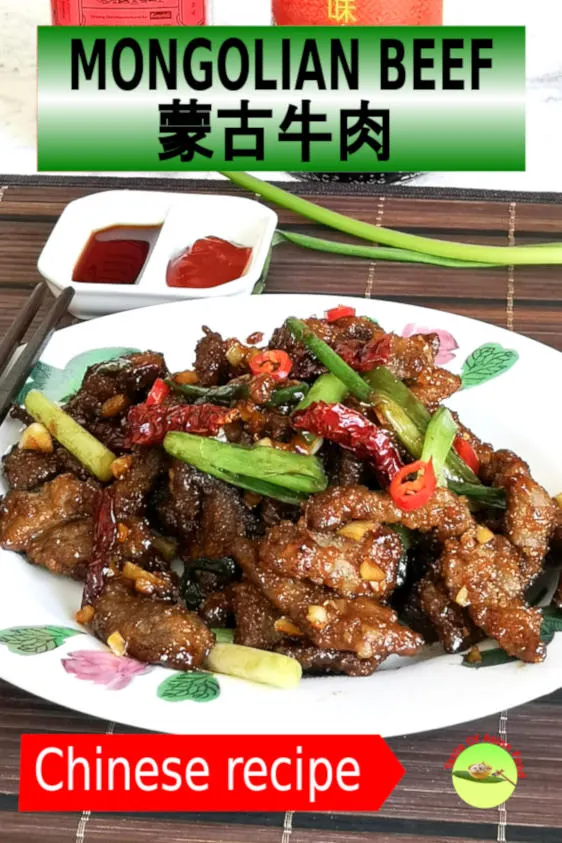
Note: This post may contain affiliate links. Please read my privacy policy for more info. I may receive commissions for purchases made through links in this post. As an Amazon Associate, I earn from qualifying purchases.
Six simple steps to cook the perfect Mongolian beef
1️⃣ Use the right cut of beef
Mongolian beef is prepared with a quick stir-frying process. Therefore, suitable cuts of beef should be tender. Certainly, it should also be without too much fat and no bone attached. For the best result, you can use tender beef like tenderloin or sirloin steak. Use flank steak or chuck and flank as the cheaper alternatives. Use skirt steak if you prefer lean meat for health reasons.
- Cut the beef into thin slices since this is a quick cooking process. The meat will contract and become thicker when you cook them.
- Since it is easy to slice partially frozen beef, I normally froze it the night before and let it defrost at room temperature the next morning. Once the beef is soft enough for cutting, slice it immediately, and you will have the thinnest pieces of beef possible.
2️⃣ Marinate the beef for better flavor
Marinating the beef with soy sauce, cornstarch, and occasionally wine is common. Some recipes include eggs to make the beef taste velvety.
I prefer marinating beef with oil, cornstarch, and light soy sauce. The gravy of Mongolian beef will eventually provide other flavors to the beef.
Marinating the beef for twenty minutes should be sufficient as the slices of beef are thin and small.
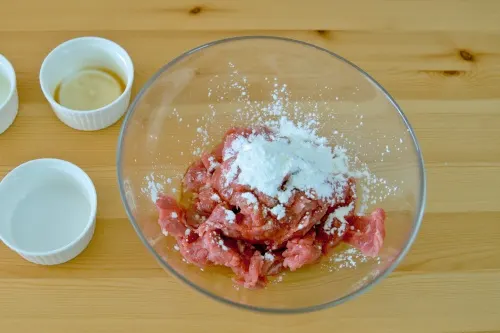
3️⃣ Coat the beef with the dry coating mix
According to most recipes, the method to prep beef is to mix the beef with cornstarch, then deep-fried.
I use a combination of three items to coat the beef before deep-frying. General Tso’s recipe also uses my formula to coat the chicken. The usage of each of these ingredients is as follows:
- Normal wheat flour. It provides the volume for the coating, so it is enough to form a thin layer to protect the beef from the hot oil’s direct heat, resulting in the beef that is most.
- Cornstarch. Increase the crispiness of the coating.
- Salt. Important to improve the flavor.
This combination is amazing because it is crunchy and not hard like the biscuit, even after half an hour after deep-frying. The magical balance of the four simple ingredients in the flour mix is perfectly suitable for Mongolian beef. It is used in this formula, and I am proud to say it turns out better than many similar dry coatings from cookbooks and chefs.
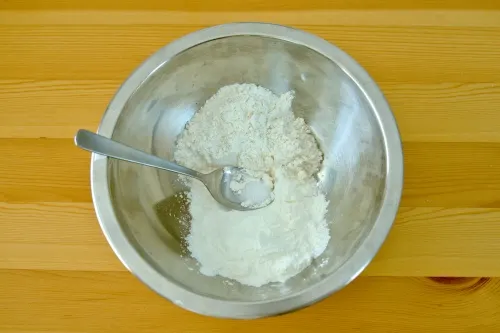

4️⃣ Deep-fry the beef over high heat
Cooks in the modern kitchen use a dedicated deep-fryer for this purpose. If you cook in a small western kitchen, you can also deep-fry it in a wok or large skillet over high heat.
Peanut oil or other vegetable oil with high smoke points is my favorite oil for deep-frying. Olive oil is not suitable because it has a relatively low smoke point.
Deep-fried the beef for two minutes at 190°c, remove and drain on a colander or paper towel.
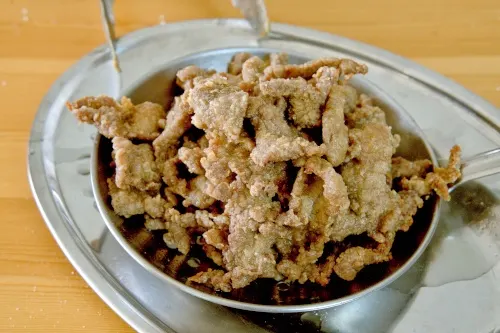
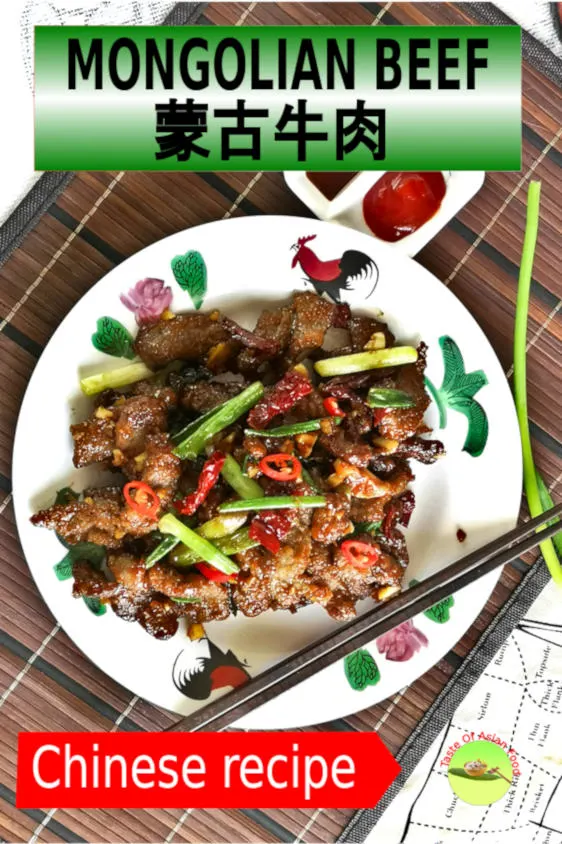
5️⃣ Make the best Mongolian beef sauce
I use the following ingredients for Mongolian beef gravy.
Soy sauce. I am using Chiese light and dark soy sauce in my recipe. Chinese light soy sauce tends to be salty, while the Chinese dark soy sauce has a caramelized flavor. Japanese soy sauce and the Indonesian sweet soy sauce (kicap manis) are not suitable for this recipe.
Sugar. The sugar in Mongolian beef is higher than in many other authentic Chinese dishes. Generally, most American Chinese foods are sweeter than their Asian counterparts. The larger quantity of sugar helps to caramelize and thicken the sauce, which means less cornstarch slurry is required for thickening,
Besides soy sauce and sugar, I also include Shaoxing wine, which is optional.
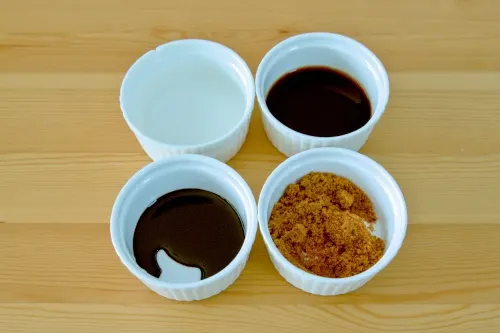
6️⃣ Mix the fried beef with the sauce to serve
The final step is to combine the spicy sauce and the beef. Flip and mix for ten seconds.
Since I want to keep the beef crispy, I do not stir-fry it with gravy for long. Instead, I only flash fry the (actually is to mix in the gravy) for just ten seconds.
One common mistake in making this dish is adding too much cornstarch slurry. It turns the gravy into a gooey mass. I do not use cornstarch to thicken the gravy in this recipe. Once the gravy is cooked down, it is already thick enough to cling to the beef to form a shiny sheen.
Note: You can add red bell pepper or green beans at the last cooking stage if you prefer to have some vegetables in this dish. Some cooks like to sprinkle some toasted sesame seeds before serving.
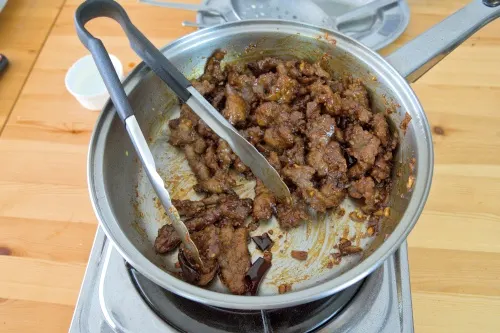
Tips for cooking the best Mongolian beef
Here are my final thought and summary before I conclude this post on how to dish out the toothsome Mongolian beef.
- Use the tender cut of the beef.
- Marinate to let the soy sauce and cornstarch absorb.
- The gravy should be thick enough to cling to the surface.
- Do not use too much sugar in the recipe. I find that most of the recipes tend to be too sweet. I have reduced the amount in my recipe accordingly.
- Use plenty of scallions. Scallions will never be too much for Mongolian beef!
- Be prudent when you add the cornstarch slurry. Since the sauce contains sugar and dark soy sauce which acts as the thickener, you may not need cornstarch slurry unless you add too much water to the sauce.
Frequently asked questions:
- How do you keep the leftover Mongolian beef?
The best way is to eat it fresh, but the leftover can be kept in an airtight container and stored in the refrigerator for up to two days. - How do you serve Mongolian beef?
Mongolian beef has a savory taste. /therefore, it is most suitable to serve with white rice. - Do I need to add Hoisin sauce to formulate the Mongolian beef sauce?
Some recipes do add some Hoisin sauce, but I do not use it and it still tastes great.
The difference between Mongolian beef and other closely related Asian dishes
There are a few stir-fried Chinese takeouts on this blog which is closely related to Mongolian beef. These are stir fry beef with ginger and scallion (薑葱牛肉), Mongolian beef (蒙古牛肉), General Tso’s chicken (左宗棠雞), and Sweet and sour chicken (咕嚕肉).
The major difference among these dishes is the savory sauce. In a nutshell, Mongolian beef is sweeter than stir-fried beef with ginger and scallion and does not include tomato ketchup as in sweet and sour chicken.
The following is the summary of the sauce ingredients for these dishes. You can access these recipes by clicking the links. If you like Mongolian beef, chances are you will also like these related stir-frying dishes.
- Mongolian beef: Light soy sauce, dark soy sauce, sugar, Shaoxing wine (optional), dried red chili (optional).
- General Tso’s chicken: Dark soy sauce, light soy sauce, Shaoxing wine, rice vinegar sugar, sesame oil, tomato paste, cornstarch.
- Sweet and sour chicken: Tomato ketchup, chili sauce 40g, plum sauce, sugar, lemon juice., salt.
- Beef Stir Fry With Ginger And Scallion: Oyster sauce, light soy sauce, sugar, salt, ground white pepper.
Note: Dried red chili should be available at the Asian grocery store near you. You can use red pepper flakes as a substitute.
The easy Mongolian beef recipe
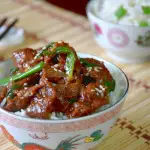
Mongolian beef
Mongolian beef is an American Chinese cuisine best serve with steamed rice.
Ingredients
Ingredients A (beef)
- 300 g beef, (sirloin, tenderloin, chuck)
- 2 teaspoons vegetable oil
- 2 teaspoons light soy sauce
- 2 tablespoons corn starch
Ingredients B (Coating powder)
- 2 tablespoons wheat flour
- 2 tablespoons cornstarch
- 1/4 teaspoon salt
Ingredients C (aromatics)
- 1 tablespoon vegetable oil
- 20 g ginger, coarsely chopped
- 3 pieces dry red chili, , cut into short pieces]
- 4 cloves garlic, coarsely chopped
Ingredients D (Gravy)
- 2 tablespoons light soy sauce
- 2 teaspoon dark soy sauce]
- 2 tablespoons brown sugar
- 1 tablespoon Shaoxing wine (optional)
- 4 tablespoons water
Ingredients E (Others)
- 2 stalks scallion, , cut to 3cm long on the diagonal
- 1 teaspoon cornstarch slurry, , constitute with 1 tsp of cornstarch with 1 tbsp of water
- vegetable oil for deep-frying
Instructions
- Cut the beef into thin slices. Marinate with the rest of the ingredient A for 15 minutes.
- Coat the marinated beef with ingredient (B). Deep-fried the beef slices in hot oil for two minutes. Remove and drained.
- Saute the rest of the ingredients (C) with oil until they turn fragrant.
- Add ingredients (D) and wait until it returns to a boil.
- Add the cornflour slurry to thicken the gravy.
- Add the beef and scallion. Flash fry for ten seconds. Serve.
Nutrition Information:
Yield: 2 Serving Size: 2 servingsAmount Per Serving: Calories: 1169Total Fat: 76gSaturated Fat: 23gTrans Fat: 0gUnsaturated Fat: 42gCholesterol: 217mgSodium: 2469mgCarbohydrates: 48gFiber: 2gSugar: 14gProtein: 71g
This data was provided and calculated by Nutritionix on 5/28/2019

Century Foods
Wednesday 3rd of November 2021
Loved your recipe’s instructions on the Mongolian beef recipe. Thanks for such amazing words.
KP Kwan
Friday 5th of November 2021
It is my pleasure to share.
Allainyaha Charlene Matthews
Wednesday 27th of October 2021
Thank you for the recipe, I am looking to make two version one mom spicy for my papa, and son who love Mongolian beef. For myself and go love it spicy more than most quick simple easy
Rick Beck
Monday 15th of February 2021
Hello Everyone , I was doing my usual thing the other nite and came across this recipe for Mongolian beef ! I was just wondering if the original chineese recipe is the one most used by those that cook this meal. Now I live with a family of four and I just wanted to know if my grandchildren will eat this main dish meal being that it's not spicy unless you use the recipe that has the spices in it. I was also wondering if this recipe can be applied to something like chicken or maybe pork. I'd really like to know if this might be possible to use another meat other than beef. Thank You for your time and your help The nutty cook Rick Beck
KP Kwan
Monday 15th of February 2021
Hi Rick, The recipe has some dry red chili in it, so it should be slightly spicy. However, you can use more chili or none according to your preference. As for the meat, I would suggest using pork if you do not eat beef. Thanks. KP Kwan
HOWARD MANDEL
Tuesday 22nd of December 2020
Nice recipe. I’ve just cooked it using chuck steak, adding green beans and mushrooms with the aromatics with a dash more of cooking wine, and drops of hot oil. Very tasty!
KP Kwan
Wednesday 23rd of December 2020
Thanks and great to know that you like it.
Francine
Wednesday 29th of May 2019
Thank you for the recipe. It sounds very good. I am going to make it this coming week-end. And I like it very much that you have a recipe for 2 persons. I am usually by myself, so I can eat it twice. Usually recipes are so large I will have to eat it the whole week or freeze it. By the way 2 lbs. are about 1 kg, not 2 kg. I have discovered a cut of beef that here they call it skirt steak. It is the continuation of flank steak towards the head of the cow, and exactly below the rib. Here is the explanation: https://en.wikipedia.org/wiki/Skirt_steak We have a lot of Latinos in our area, so I found a Latino grocery store and when I asked what is the beast meat that is not too expensive for steak, they showed me the Skirt steak. It is very flavorful and tender. I love cooking it very simply with lots of onions, green onions, and cooking it with Indonesian soy sweet soy sauce, Worcestershire sauce, wine, salt and pepper and butter.